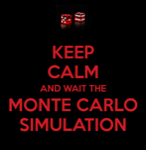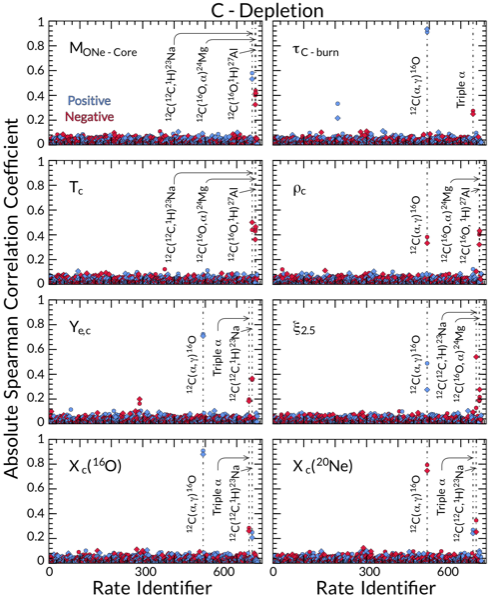
|
Cococubed.com
|
| Monte Carlo Massive Stars |
Home
Astronomy research
Software Infrastructure:
MESA
FLASH-X
STARLIB
MESA-Web
starkiller-astro
My instruments
Neutrino Emission:
Neutrinos from de-excitation
Neutrino emission from stars
Identifying the Pre-SN
Neutrino HR diagram
Pre-SN Beta Processes
Pre-SN neutrinos
White dwarf pulsations:
12C(α,γ) & overshooting
Probe of 12C(α,γ)16O
Impact of 22Ne
Impact of ν cooling
Variable white dwarfs
MC reaction rates
Micronovae
Novae
White dwarf supernova:
Stable nickel production
Remnant metallicities
Colliding white dwarfs
Merging white dwarfs
Ignition conditions
Metallicity effects
Central density effects
Detonation density
Tracer particle burning
Subsonic burning fronts
Supersonic fronts
W7 profiles
Massive stars:
Pop III with HST/JWST
Rotating progenitors
3D evolution to collapse
MC reaction rates
Pre-SN variations
Massive star supernova:
Yields of radionuclides
26Al & 60Fe
44Ti, 60Co & 56Ni
SN 1987A light curve
Constraints on Ni/Fe
An r-process
Effects of 12C +12C
Neutron Stars and Black Holes:
Black Hole spectrum
Mass Gap with LVK
Compact object IMF
He burn neutron stars
Stars:
Hypatia catalog
SAGB stars
Nugrid Yields I
He shell convection
BBFH at 40 years
γ-rays within 100 Mpc
Iron Pseudocarbynes
Pre-Solar Grains:
C-rich presolar grains
SiC Type U/C grains
Grains from massive stars
Placing the Sun
SiC Presolar grains
Chemical Evolution:
Radionuclides in 2020s
Zone models H to Zn
Mixing ejecta
Thermodynamics, Opacities & Networks
Radiative Opacity
Skye EOS
Helm EOS
Five EOSs
Equations of State
12C(α,γ)16O Rate
Proton-rich NSE
Reaction networks
Bayesian reaction rates
Verification Problems:
Validating an astro code
Su-Olson
Cog8
Mader
RMTV
Sedov
Noh
Software Instruments
2026 AAS Journals
AAS YouTube
Listing of 500+ Author Videos
AAS Peer Review Workshops
Outreach Material
Education Material
Other Stuff:
Bicycle Adventures
Illustrations
Presentations
Contact: F.X.Timmes
my one page vitae,
full vitae,
research statement, and
teaching statement.
In this article we explore properties of core-collapse supernova progenitors with respect to the composite uncertainties in the thermonuclear reaction rates by coupling the reaction rate probability density functions provided by the STARLIB reaction rate library with MESA stellar models.
We evolve 1000 15 M$_{\odot}$ models from the pre main-sequence to core O-depletion at solar and subsolar metallicities for a total of 2000 Monte Carlo stellar models. For each stellar model, we independently and simultaneously sample 665 thermonuclear reaction rates and use them in a MESA in situ reaction network that follows 127 isotopes from $^{1}$H to $^{64}$Zn. With this framework we survey the core mass, burning lifetime, composition, and structural properties at five different evolutionary epochs. At each epoch we measure the probability distribution function of the variations of each property and calculate Spearman Rank-Order Correlation coefficients for each sampled reaction rate to identify which reaction rate has the largest impact on the variations on each property.
We find that uncertainties in $^{14}$N$(p,\gamma)^{15}$O, triple-$\alpha$, $^{12}$C$(\alpha,\gamma)^{16}$O, $^{12}$C($^{12}$C,p)$^{23}$Na, $^{12}$C($^{16}$O,p)$^{27}$Al, $^{16}$O($^{16}$O,n)$^{31}$S, $^{16}$O($^{16}$O,p)$^{31}$P, and $^{16}$O($^{16}$O,$\alpha$)$^{28}$Si reaction rates dominate the variations of the properties surveyed. We find that variations induced by uncertainties in nuclear reaction rates grow with each passing phase of evolution, and at core H-, He-depletion are of comparable magnitude to the variations induced by choices of mass resolution and network resolution. However, at core C-, Ne-, and O-depletion, the reaction rate uncertainties can dominate the variation causing uncertainty in various properties of the stellar model in the evolution towards iron core-collapse.

|

|
 |

|

|

|